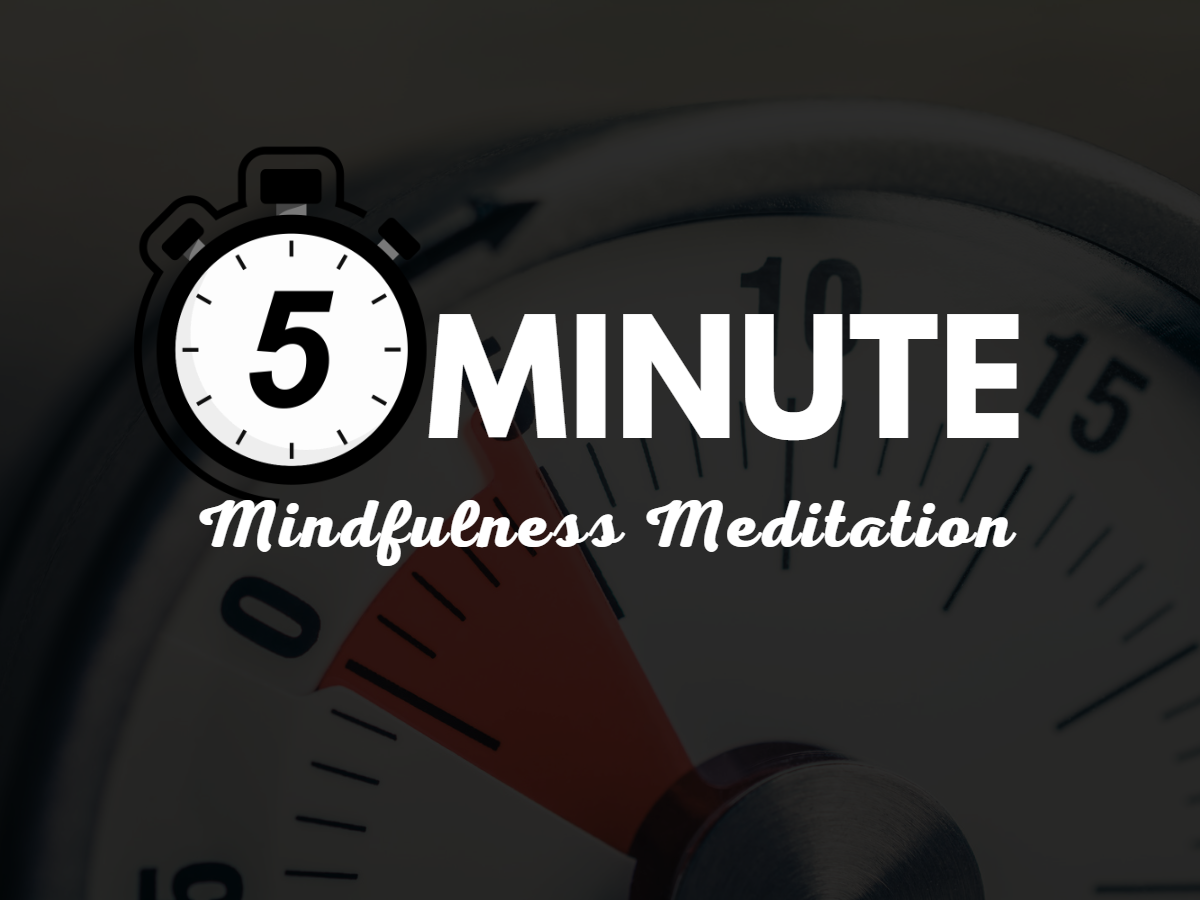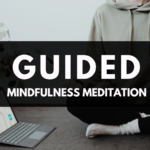5-Minute Mindfulness Meditation
Are you looking for a way to bring more peace and focus into your life?
Mindfulness meditation is the solution you need.
Even if you only have five minutes a day, you can start to reap the benefits of this powerful practice.
In this post, we’ll explore the benefits of a 5-minute mindfulness meditation and provide some simple techniques and activities to help you get started.
The Benefits of a 5-Minute Mindfulness Meditation
Improved Focus and Concentration:
A 5-minute mindfulness meditation practice can help improve your concentration and focus by helping you train your mind to stay in the present moment and avoid distractions. Focusing on your breath or a specific sensation can improve your ability to concentrate and enhance your performance at work or in other activities.
Reduced Stress and Anxiety:
One of the most significant benefits of a 5-minute mindfulness meditation is that it helps reduce stress and anxiety. Research has shown that regular meditation can decrease cortisol levels. As a result, it can help people feel more relaxed and less anxious.
Increased Self-awareness:
A 5-minute mindfulness meditation can help increase your self-awareness. You can better understand yourself by focusing on your thoughts and emotions without judgment. This self-awareness can help you identify negative thought patterns or behaviors that may be holding you back from achieving your goals.
Better Emotional Regulation and Management:
Regular mindfulness meditation practice can help people better regulate their emotions. It can help people respond more calmly to stressful situations and manage their emotions more effectively. This can lead to healthier relationships and better overall well-being.
Improved Overall Well-being:
A 5-minute mindfulness meditation can help improve your overall well-being. It can help reduce physical symptoms of stress, such as headaches, muscle tension, and fatigue.
Additionally, regular practice can help improve sleep quality, enhance immune function, and decrease the risk of chronic diseases.

PERMISSIONS: You may read aloud the guided meditation script published below in live settings, such as private sessions, classes, workshops, worship services, therapy groups, and other gatherings. You may make a recording of this script for personal use. You may not use this script for audio, video, or other types of recordings that are given away, sold, or otherwise distributed in quantity. You must contact us directly for written permission to use material on this website beyond the limits set forth above.
How to Do a 5-Minute Mindfulness Meditation
Step-by-Step Instructions for a Basic Mindfulness Meditation Practice:
- Find a calm and comfortable place to sit.
- Set a timer for 5 minutes.
- Close your eyes or keep them slightly open, whichever feels more comfortable.
- Take a few deep breaths and focus on your breath going in and out.
- If your mind wanders, try to bring your attention back to your breath.
- Notice any thoughts, emotions, or sensations without judgment, and let them pass.
- When the timer goes off, slowly open your eyes. Then take a few deep breaths before returning to your daily activities.
Tips for Getting Started and Staying Consistent
- Start small: Begin with a 5-minute meditation session and gradually increase the time as you feel more comfortable.
- Set a regular schedule: Choose a time of day that works best for you and try to stick to it.
- Find a comfortable position: Sit in a comfortable chair or cushion, and make sure your back is straight but not tense.
- Use guided meditations: Use a guided meditation app or recording to help you stay focused and on track.
- Be patient with yourself: Meditation takes practice. You must be patient and kind to yourself as you learn.

Common Challenges and How to Overcome Them
Finding the time:
One of the biggest challenges to establishing a mindfulness meditation practice is finding the time to do it. Many people lead busy lives with packed schedules, and finding an extra 5 minutes in the day can seem impossible.
To overcome this challenge, schedule your mindfulness meditation practice consistently each day. The best time for you is in the morning before the day starts, during a lunch break, or in the evening before bed. Making your mindfulness practice a part of your daily routine makes you more likely to stick with it.
Difficulty focusing:
Another common challenge in mindfulness meditation is difficulty focusing. Staying present and focused on the breath or a particular sensation can be challenging, especially when your mind is racing with thoughts and distractions.
To overcome this challenge, try returning your attention to the present moment whenever you notice your mind has wandered. Consider counting your breaths, repeating a mantra or phrase, or using a guided meditation to help keep your attention focused. It is important to remember that the mind will naturally wander. Mindfulness meditation is about noticing when that happens and gently bringing your attention back to the present moment.
Restlessness:
If you feel restless during your meditation practice, don’t worry, it’s completely normal. Our minds are used to being constantly stimulated, and sitting still and quiet can be a challenge.
Instead of fighting restlessness, try to observe it without judgment. Notice the sensation of restlessness in your body, and allow it to be there without trying to push it away. This approach can help you develop greater acceptance and self-awareness.

Distractions:
Distractions can be a significant challenge when it comes to mindfulness meditation. It is common to experience distractions during meditation, especially if you’re a beginner.
Distractions could be anything from external noises like the sound of traffic to internal distractions like thoughts, worries, or emotions.
These distractions can take your focus away from your breath or meditation practice, making it difficult to remain present.
The most effective way to overcome distractions is to acknowledge them without judgment and gently bring your focus to your breath or meditation practice. Remember, distractions are a natural part of meditation, and it’s perfectly okay to experience them. Instead of resisting or fighting them, try to accept them and let them pass.
Another way to minimize distractions is to create a suitable environment for your meditation practice. You can choose a quiet, comfortable space free from external distractions. If you find it challenging to meditate in a quiet space, try calming music or white noise to help you focus.
Self-criticism:
When starting a new practice, being critical of ourselves and our abilities is common. This can be particularly true regarding mindfulness meditation, as we may feel like we are “doing it wrong” or not seeing immediate results.
To overcome this challenge, try to approach your mindfulness practice with a sense of curiosity and compassion.
Remember that mindfulness meditation is a skill that takes time and practice to develop, and it is not something that can be perfected overnight.
You should celebrate your successes, no matter how small, and be gentle with yourself when you face challenges or setbacks.
By acknowledging and addressing these common challenges, you can be better prepared to establish a consistent and rewarding mindfulness meditation practice.
Impatience:
Impatience is another common challenge when practicing mindfulness meditation, especially for beginners.
Many people expect to see immediate results and get frustrated when they don’t feel the benefits right away. This can lead to discouragement and even cause people to give up on the practice altogether.
It’s important to remember that mindfulness meditation is a practice that requires patience and consistency. It’s not a quick fix but rather a long-term habit that can have numerous benefits if done regularly.
Setting realistic expectations and recognizing that progress takes time can help alleviate impatience and motivate you to continue the practice. It can also be helpful to track your progress as well as celebrate small wins along the way.
You may notice that you can focus for a few extra seconds or that your mind doesn’t wander as much as it did during your first few sessions. Recognizing these small improvements can boost your confidence and help you stay committed to the practice.
Another way to overcome impatience is to find a community of like-minded people practicing mindfulness meditation. This can provide a sense of accountability, support, and opportunities to learn from others and share experiences.

Overall, impatience is a common challenge when it comes to mindfulness meditation.
Still, it’s important to remember that progress takes time and consistency. Setting realistic expectations, tracking progress, and finding a supportive community can help you overcome this challenge and stay committed to the practice.
5-minute mindfulness activities for adults
- Body scan meditation: Sit or lie down comfortably and focus on each part of your body, from your head to the tips of your toes. Observe any sensations without judgment or reaction.
- Breath counting: Close your eyes and focus on your breath. Count each inhale and exhale cycle up to 10. If you lose count, start again from one. This helps improve concentration and focus.
- Mindful walking: Take a 5-minute walk, paying attention to your surroundings. Focus on each step’s sights, sounds, and sensations.
- Gratitude practice: Take a few moments to think of three things you’re grateful for. They can be simple things like having a warm bed or a supportive friend.
- Loving-kindness meditation: Sit quietly and repeat phrases of love and kindness to yourself, such as “May I be happy, may I be healthy, may I be at peace.” You can extend this practice to others as well.
- Mindful eating: You can take a small piece of food, such as a raisin, and eat it slowly, savoring each bite. Notice the flavors, textures, and sensations in your mouth.
- Progressive muscle relaxation: Try to tense and relax each muscle group in your body, starting from your toes and working your way up to your head. This helps release physical tension and promotes relaxation.
- Listening meditation: Choose a sound in your environment, such as birds singing or traffic passing by, and focus on it. Notice how the sound changes and evolves over time.
- Visual meditation: Choose a simple object, like a candle or a flower, and focus on it. Observe its shape, color, and texture without judgment or interpretation.
- Guided meditation: Use a guided meditation app or video to take you through a 5-minute mindfulness practice. There are many options available for free online.

5-minute mindfulness activities for students:
Children and young people can also benefit from practicing mindfulness regularly. It can help them manage stress, improve their concentration, and boost their overall well-being.
Here are some 5-minute mindfulness activities for students that they can do at school or at home:
- Belly Breathing: Ask the students to sit comfortably with their feet on the floor and their hands on their bellies. Then ask them to take a deep breath through their nose, feel their belly expand, and exhale slowly through their mouth, feeling their belly contract. Encourage them to focus on their breath and the movement of their belly for five minutes.
- Sensory Awareness: Ask the students to sit comfortably with their eyes closed or lowered. Then ask them to focus on each of their senses, one at a time. For example, they could focus on the sounds they hear, the sensations in their body, the smells around them, the tastes in their mouth, and the sights they see when they open their eyes. Encourage them to notice each sensation without judgment or analysis for five minutes.
- Body Scan: Ask the students to lie down on their backs with their arms by their sides and their eyes closed. Then guide them through a body scan, asking them to focus on each part of their body, starting from their toes and moving up to their head. Encourage them to notice any sensations they feel in each part of their body and to let go of any tension they may be holding. Guide them through the exercise for five minutes.
- Gratitude Practice: Ask the students to sit comfortably and think of something or someone they are grateful for. It can be anything as simple as a favorite food or a friend who makes them happy. Encourage them to focus on the feeling of gratitude in their body and to spend five minutes reflecting on why they are grateful for that thing or person.
- Mindful Movement: Ask the students to stand up and do some simple movements mindfully. For example, they could raise their arms above their head and then lower them slowly, paying attention to the sensation in their body as they move. They could also do gentle stretches or yoga poses mindfully, focusing on each movement and the breath. Encourage them to move slowly and deliberately for five minutes.
By incorporating these 5-minute mindfulness activities into their daily routine, students can develop their mindfulness skills and reap the benefits of this practice.
Final Thoughts:
Incorporating a 5-minute mindfulness meditation into your daily routine can be a game changer. Taking just a few moments each day to be present and aware can improve your focus, reduce your stress levels, and enhance your overall well-being. So why not give it a try? Whether you’re a busy professional or a student with a packed schedule, there’s always time for a quick mindfulness meditation practice.
Now take a deep breath, let go of your worries, and fully embrace the present moment.







